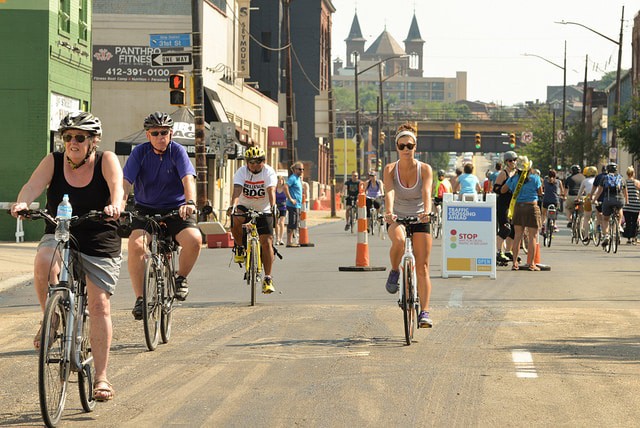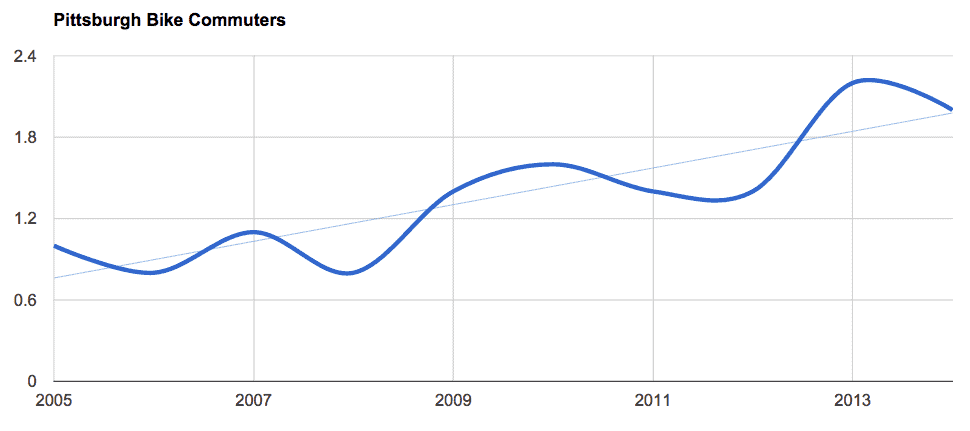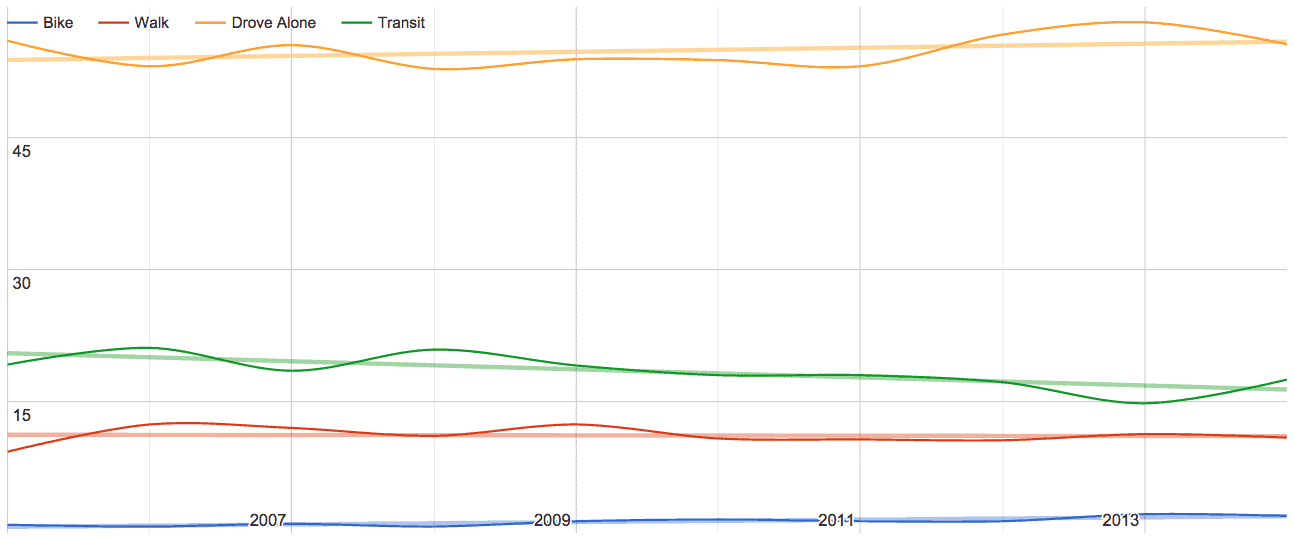
Participants enjoying July’s OpenStreets event
Trends from ten years of ACS data
Here it is, our annual look at commuting trends in Pittsburgh and beyond. Every September, the US Census posts their American Community Survey (ACS) transportation stats for the previous year.
This is now our ninth year reporting on the data for the 60 largest US cities, and the 2014 results are impressive for biking and walking, to say the least (2006) (2007) (2008) (2009) (2010) (2011) (2012) (2013). As the ACS has some flaws, these numbers should not be taken at face value (see below). Rather they offer insight into the trends within the city and across the nation. The City’s new bike count program will help us gain a better picture of what is going on in the real world.
This year, we decided to do something a bit different and show how Pittsburgh has changed over the past 10 years of the survey.
Some 2014 Pittsburgh highlights:
- Doubling of bike commuters since city began installing bike lanes in 2007
- Top 4 walking city
- Top 11 biking city
- Top 5 bike+walk
- Top 8 bike+walk+transit
- 9th least single occupancy drivers
- 10th most transit
click tabs to toggle between modes
Here is a breakdown of the top 20 “green” transportation cities, aka bike, walk, transit.
Click tabs to toggle between modes
Below is a chart representing the commuter breakdown of biking, walking, public transit, and driving alone in the top biking cities. This is simply here to see how these cities compare in modal breakdown. Note that these won’t add up to 100% since we didn’t add carpooling, taxi, or working from home in the chart.
Modal breakdown of top biking cities – click image to enlarge
Snapshot of the past decade 2005-2014
We’ve come a long way in the past 10 years. Anyone who’s been here since then can tell you there are way more people riding bikes now than there were back then. Below is a snapshot of Pittsburgh commuting trends over the last decade. Note that the city began installing bike lanes in earnest in 2007, with the installation of the Liberty Ave bike lanes in Bloomfield.
Pittsburgh bike commuter trend 2005-2014
Below is a chart of commuting trends for biking, walking, transit, and driving alone over the past decade. Notice how closely the “drove alone” category inversely mimics the public transit ridership. The effect of the transit cuts over time can be seen, so next time you’re driving and stuck in traffic or looking for parking, think about this chart and how important it is to support transit.
Select commuter trend 2005-2014
While not perfect, the ACS data is the best data available to help us understand trends in the United States. These stats specifically look at “what is the primary way that Pittsburgh residents get to their job (wherever that may be)?” And of course, because we love cities, not to mention a friendly competition, we’ve included the largest 60 cities in our analysis. This is not a sample of “how many Pittsburghers ride bikes.”For instance, if you take the bus to your job, but ride a bicycle the rest of the time, you are counted as “transit.” Likewise if you ride a bicycle 3 days and drive 2 days, you are counted as “bicycle.” And if you have no job, are under 16, or are a student, well you’re just not counted. Although this is most likely the best data that we have available on this subject, please see the caveats at the end of this post regarding the ACS data.
What is the American Community Survey?
The American Community Survey is the country’s largest household survey, reporting its findings every year. With a sample size of about 3 million addresses, this is only an estimate, but is by far the best tool that we have understanding trends in the United States. The survey uses questionnaires and interviews to gather information on demographic, economic, and housing characteristics.
ACS limitations, notes, and cautions
- The ACS asks only about commuting. It does not tell us about bicycling for non-work purposes.
- Results are based on a survey of a sample of the population. Surveys take place throughout the year. The journey to work question asks respondents about the previous week.
- The journey to work question asks about the primary mode of transportation to work. The wording of the question undercounts the actual amount of bike commuting that occurs. It does not count people who rode once or twice a week or people who bike to transit (if the transit leg is longer than the bike leg).
- Since the ACS is a survey of a sample, the results are estimates. The ACS releases a margin of error along with the estimate. Users can add and subtract the margin of error value from the estimate to find the top and bottom of the range within which the ACS is 90 percent confident in their estimate lies. Margins of error are reported on with the data on the ACS site.
- Changes among years may not be statistically significant.
- The numbers reported here are for the “principal city,” not the larger Metropolitan Statistical Area (MSA).
 Not a member of BikePGH? Join today! We need you to add your voice! Bike Pittsburgh works to protect cyclist’s rights and promote the vision of making Pittsburgh a safer and more enjoyable place to live and to ride. For more info, check out: www.bikepgh.org/membership…..
Not a member of BikePGH? Join today! We need you to add your voice! Bike Pittsburgh works to protect cyclist’s rights and promote the vision of making Pittsburgh a safer and more enjoyable place to live and to ride. For more info, check out: www.bikepgh.org/membership…..




7 Comments
[…] on the Network today: Bike Pittsburgh tallies up the thoroughly impressive active commuting stats from the Steel City. Greater Greater […]
[…] data shows that more people are moving to cities and more people are riding bikes. Fortunately for our city, many recent developers have been following these trends and are […]
[…] should be a particularly clear priority for a community where so many people get to work on foot. Data from the American Community Survey (ACS) for 2014 pegs Pittsburgh as the 4th largest city for walk commuting […]
[…] Trip Count survey looked at how people made individual trips to and from the office. Compared to traditional transportation surveys that typically focus on primary mode, this approach allowed the survey to gather a more complete […]
[…] about 11% of Pittsburgh workers walk to work according to Census data. So unshoveled sidewalks create a significant commute hazard to more than […]
[…] It’s worth mentioning that many of the stats in the report are taken directly from the US Census’ American Community Survey (ACS), something that we have been reporting on for nearly a decade. The ACS data looks […]
[…] on the data for the 60 largest US cities (2006) (2007) (2008) (2009) (2010) (2011) (2012) (2013) (2014). As the ACS has some flaws, these numbers should not be taken at face value (see […]